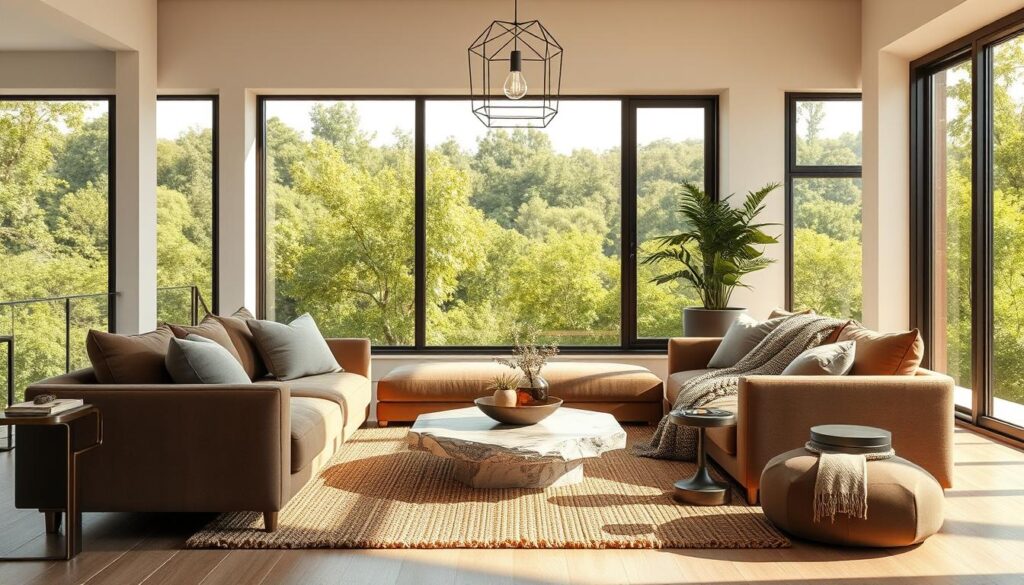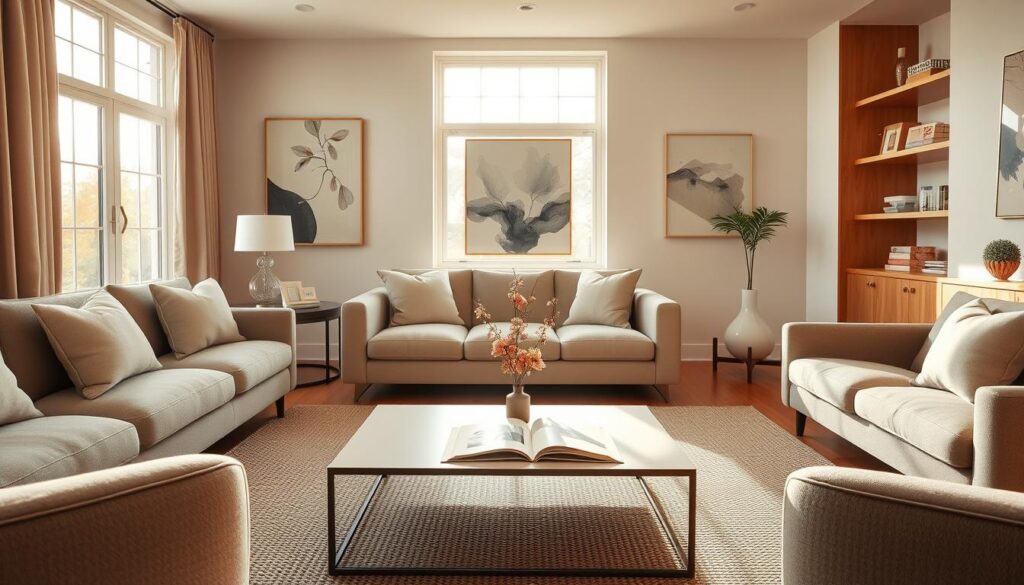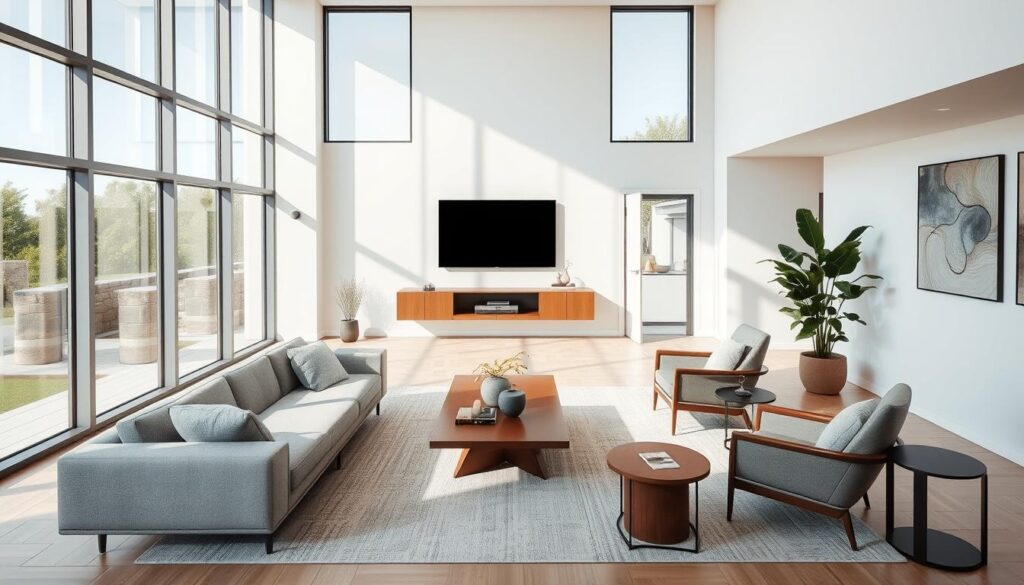Did you know a well-designed interior can boost a home’s value by up to 10%? With the growing interest in interior design, making a modern and useful living area is key. A well-designed interior combines beauty and function.
We’ll share our best tips for creating a stylish and cozy space. We’ll cover the basics of modern design, essential elements, picking furniture, and more.
Key Takeaways
- Understand the principles of modern design
- Learn how to select functional and stylish furniture
- Discover the importance of lighting in interior design
- Explore how to create a cohesive look throughout your home
- Find out how to balance aesthetics with functionality
The Principles of Modern Home Design
Modern home design focuses on simplicity, functionality, and being green. We aim to make homes that look good and work well. They also need to be good for the planet.
This style is known for its clean look and use of natural light. It’s not just about looks; it’s about making spaces feel open and warm. Knowing these principles helps homeowners create a modern, welcoming home.
Understanding Minimalism
Minimalism is key in modern design. It’s about cutting down on clutter and focusing on what’s essential. Minimalist design aims to bring calm and serenity to a home.
In a minimalist home, you’ll see clean lines and simple shapes. It’s all about function, with each item having a purpose. This makes the home feel bigger and more open.
Emphasizing Functionality
Functionality is vital in modern design. A home should meet its occupants’ needs. This means creating spaces that are efficient, practical, and cozy.
| Design Element | Functional Benefit |
|---|---|
| Multi-functional furniture | Saves space and enhances usability |
| Open floor plans | Improves flow and social interaction |
| Smart home technology | Enhances convenience and energy efficiency |
Using Natural Light
Natural light is crucial in modern design. It cuts down on the need for artificial light and adds warmth. We use big windows, skylights, and mirrors to bring in more light.
By following these principles, homeowners can make a modern home that’s both beautiful and practical. As shown in the image below, contemporary decor often includes open spaces and lots of natural light.
In summary, modern home design is all about simplicity, function, and connecting with nature. By embracing these ideas, we can build homes that are stylish, useful, and eco-friendly.
Key Elements of Modern Interior Design
Modern interior design is all about simplicity and function. It combines several key elements to make a stylish and cohesive space.
Color Palettes
Modern design often starts with neutral colors. These colors, like whites, grays, and beige, create a calm background. They also let you add bold decor easily.
Decorative Elements
Decor in modern design is chosen for looks and function. Geometric patterns and minimalist art add interest. The goal is to balance beauty and usefulness.
Flooring Options
Flooring is key in modern design. Hardwood and stone are favorites for their durability and style. The right flooring can change a room’s look and feel.
| Material | Durability | Style |
|---|---|---|
| Hardwood | High | Classic, Timeless |
| Stone | High | Modern, Elegant |
| Laminate | Medium | Versatile, Affordable |
Choosing the right colors, decor, and flooring makes a modern space stylish and useful. Each part is important in creating a space that shows your style and follows modern design principles.
Furniture Selection for Modern Interiors
In modern home design, the furniture we choose is key to a unified look. We seek pieces that are stylish, functional, and can grow with us.
Choosing the Right Pieces
When picking furniture for a modern home, we focus on trendy house furnishings that look good and work well. A sleek sofa, for example, can be both eye-catching and comfy. You can find many stylish options at 2modern.com, which has a wide range of modern furniture designs.
The Importance of Scale
Furniture size is vital for room balance. Too big, and it takes over; too small, and it gets lost. We measure our rooms carefully and choose furniture that fits just right, keeping the space open and airy.
Multi-Functional Furniture Solutions
In modern homes, furniture that does more is prized. Items like storage ottomans or extendable dining tables are perfect. They help keep our spaces tidy and functional, fitting the minimalist style of modern design.
By choosing our furniture wisely, we can greatly improve our modern homes’ looks and use. It’s all about finding the perfect mix of style, size, and function.
Lighting in Modern Home Design
Lighting is key in modern home design. It changes spaces and makes luxury home interiors better. We look at different lighting aspects to help homeowners.
Types of Lighting Fixtures
Modern homes use many lighting fixtures. These include overhead lights, table lamps, floor lamps, and accent lights. Each has its own role in lighting a room.
Overhead lights give general light. Table and floor lamps are for specific tasks. Accent lights highlight certain areas. Mixing these lights makes a room look good and work well.
Layering Light Effectively
Layering light makes homes warm and welcoming. It’s about mixing light sources for a balanced look. This means using ambient, task, and accent lights together.
To layer light well, start with ambient light. Then add task light for specific areas. Use accent light to focus on certain features or decor.
Incorporating Smart Technology
Smart technology has changed how we control home lighting. With smart lights, you can change brightness, color, and turn them on/off with your phone or voice. It’s a big step forward in home lighting.
For more on using light in modern design, check out our guide on lighting modern interior design.
| Lighting Type | Purpose | Examples |
|---|---|---|
| Ambient Lighting | General Illumination | Overhead Lighting, Recessed Lighting |
| Task Lighting | Illuminating Specific Tasks | Table Lamps, Floor Lamps, Under Cabinet Lighting |
| Accent Lighting | Highlighting Features or Decor | Spotlights, Picture Lights, LED Tapes |
Integrating Technology into Modern Interiors
The modern home is a place of innovation, where tech meets design for a smooth living experience. Our homes are getting more tech-savvy, making life easier, more fun, and comfortable.
Smart home systems are a big part of this change. They let us control our homes, from lights and temperature to security and fun, all from one spot.
Smart Home Systems
Smart home systems are changing how we live. They let us manage our homes from anywhere, making life easier and more flexible.
“The future of home design is not just about looking good, it’s about being smart and efficient.” –
One great thing about smart home systems is how they boost home security. They offer remote monitoring and alerts, keeping us safe even when we’re away.
Innovative Appliances
Innovative appliances are also key in modern design. They’re not just useful; they work well with smart homes, offering cool features like saving energy and auto-maintenance.
| Appliance | Feature | Benefit |
|---|---|---|
| Smart Refrigerator | Automated grocery tracking | Reduces food waste and saves time |
| Smart Oven | Remote cooking control | Enhances cooking convenience and flexibility |
| Smart Washing Machine | Energy efficiency and automated maintenance | Saves energy and reduces maintenance costs |
Home Automation Benefits
Home automation brings many perks, like more convenience, saving energy, and better security. By adding tech to our homes, we make them more comfy, green, and fun.
Looking ahead, tech will keep shaping our homes. By embracing these changes, we can make our homes not just pretty but also smart and responsive to us.
Textures and Materials in Modern Design
Using textures and materials is key to making stylish living spaces that feel good and work well. They add depth and interest to modern homes.
Textures can be mixed to make a space look great. You can pair smooth with rough, or metallic with natural fibers.
Mixing and Matching Textures
Start with a main texture, like a plush rug, and add others like smooth wood or metal. This makes your space rich and interesting.
For example, in a living room, mix a leather sofa with a chunky throw and a wooden table. It adds depth and invites you to touch.

Sustainable Material Choices
Choosing sustainable materials is good for the planet and adds character to your space. Options include reclaimed wood, bamboo, and recycled metal.
These materials tell a story and add history to your room. They make your space more personal and engaging.
The Role of Wood in Modern Spaces
Wood is always in style in modern design. It brings warmth and beauty to any room. You can use it for floors, walls, or furniture.
Wood can be stained, painted, or left natural. This makes it perfect for furniture and decor. It helps create a cozy, welcoming feel in stylish living spaces.
Creating Open Spaces
Open spaces are key in modern homes, offering freedom and flexibility. They make living spaces feel bigger and more connected. This is a big plus in modern home renovations.
Benefits of Open Floor Plans
Open floor plans let in more natural light. This makes homes brighter and more inviting. They also make moving around easier, improving the flow of the space.
More natural light and better flow are big reasons why open floor plans are popular today.
How to Define Areas in Open Spaces
To make open spaces work, use furniture, rugs, and design elements. For example, a rug can mark a seating area. A console table can separate a living and dining space.
- Use furniture to create separate zones within the open space.
- Select rugs that complement the overall design while defining specific areas.
- Incorporate plants or decorative screens to add visual separation.
Transitioning Between Rooms
Open spaces make moving between rooms smooth. To keep this feel, use a consistent design theme. This makes the space feel larger and more connected.
“The key to a successful open space design is creating a cohesive look that ties together different areas, making the space feel larger and more connected.”
Choosing furniture and decor that match can create a harmonious, spacious home. This makes living there a joy.
Incorporating Personal Touches in Design
Adding personal elements to your home decor makes it truly yours. Modern design often means minimalism, but personal touches can make your space unique. They reflect your style.
Showcasing Artwork and Decor
Displaying artwork and decor that speaks to you is a simple way to personalize your home. This could include your favorite art, family heirlooms, or items with a story. For example, a bold art piece can set the mood for a room.
Exploring different styles can help you find what you like. Check out our guide on interior home styles for inspiration.

Customizing Furniture
Customizing furniture lets you add your personality to your home. Tailoring furniture to your needs and style makes your space unique. You might reupholster a sofa or create a custom piece for a tricky spot.
This approach adds character and ensures each piece has a purpose.
Personal Collections as Design Elements
Personal collections can be powerful design elements. They could be vintage items, antique furniture, or books. Displaying them in a way that catches the eye can enhance your space’s personality.
Try grouping similar items or using them to spark conversations in your living room.
| Design Element | Personal Touch | Benefit |
|---|---|---|
| Artwork and Decor | Reflects personal taste and interests | Adds character to the room |
| Customized Furniture | Tailored to specific needs and style | Creates a unique living space |
| Personal Collections | Adds depth and personality | Creates visual interest and conversation starters |
By adding these personal touches, you can create a chic home decor that’s both beautiful and tells your story. It’s about blending modern design with your personal style. With these tips, your home will be stylish and meaningful.
Tips for Achieving Cohesion in Your Design
Creating a stylish living space needs focus and a clear plan. It’s key to make your design look good together. This makes your home look better and feel more welcoming.
Establishing a Visual Identity
Use a few colors and the same design elements in your home. This creates a look that ties everything together. It makes your home feel like one big, stylish space.
Unifying with Accessories
Accessories can make your home look more put together. Pick items that match your home’s style. This way, everything looks like it belongs together.
Flow and Functionality
How your home flows is very important. It affects how you move around and enjoy your space. Make sure your home is laid out well and works for you.


